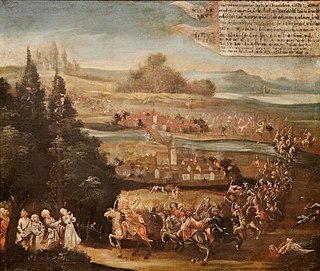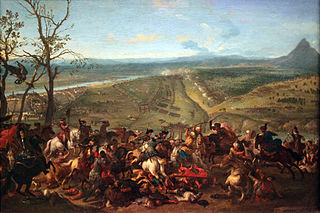The siege
In the summer of 1693, the Duke of Croy was given supreme command of the imperial troops in Hungary. On 5 July, a Turkish army under the grand vizier Bozoklu Mustafa Pasha set out from Edirne against Transylvania. Croy therefore decided to attack the strategically important fortress of Belgrade in order to lure the Turkish army away from Transylvania. The Ottomans had only recaptured the fortress in 1690 and renovated the fortifications in 1692 under Grand Vizier Çalık Ali Pasha.
Croy began the siege on 31 July with around 28,000 men. The garrison consisted of up to 12,000 Turks under Ca’fer Pasha. The Austrians were still waiting for reinforcements. They first crossed the Sava using a bridge built from the Gypsy Island. They then entrenched themselves near the village of Bisniza, out of range of the fortress's cannons. The Duke had received good information from the architect of the fortress, Andrea Cordona, but not all of it. He continued to wait for instructions from the Imperial War Council. On 14 August, the Turks made a successful sortie, and the field marshal was only just able to regroup his army.
The siege guns did not arrive until 26 August, and the Danube ships announced for May only on 1 September. But there were far too few of them; the Turkish fleet was about 10 times larger.
The relief army under the grand vizier Bozoklu Mustafa Pasha was also reported to be approaching. Croy wanted to save his honor and attempted all out assault. The attack on the night of 17 September however failed, not surprisingly. After suffering serious losses, the Austrians began to retreat to Petrovaradin Fortress. The army was pursued by Tatar horsemen and a battle broke out two hours before Petrovaradin, in which the Austrians lost their prisoners and their loot.

Ahmed II was the sultan of the Ottoman Empire from 1691 to 1695.
Köprülüzade Fazıl Mustafa Pasha ("Köprülü Mustafa Pasha the Wise", also known as Gazi Fazıl Mustafa Köprülü served as the Grand Vizier of the Ottoman Empire from 1689 to 1691, when the Empire was engaged in a war against the Holy League countries in the Great Turkish War. He was the son of Ayşe Hatun, of Turkish origin, and of Köprülü Mehmed Pasha. He was thus a member of the Köprülü family of Albanian origin through his father. His father, his elder brother Köprülü Fazıl Ahmed Pasha, as well as his two brothers-in-law were former grand viziers. His epithet Fazıl means "wise" in Ottoman Turkish.

The Battle of Slankamen was fought on 19 August 1691, near Slankamen in the Ottoman Sanjak of Syrmia, between the Ottoman Empire, and Habsburg Austrian forces during the Great Turkish War.

The Austro-Turkish War (1716–1718) was fought between Habsburg monarchy and the Ottoman Empire. The 1699 Treaty of Karlowitz was not an acceptable permanent agreement for the Ottoman Empire. Twelve years after Karlowitz, it began the long-term prospect of taking revenge for its defeat at the Battle of Vienna in 1683. First, the army of Turkish Grand Vizier Baltacı Mehmet defeated Peter the Great's Russian Army in the Russo-Turkish War (1710–1711). Then, during the Ottoman–Venetian War (1714–1718), Ottoman Grand Vizier Damat Ali reconquered the Morea from the Venetians. As the guarantor of the Treaty of Karlowitz, the Austrians threatened the Ottoman Empire, which caused it to declare war in April 1716.

The Battle of Zenta, also known as the Battle of Senta, was fought on 11 September 1697, near Zenta, Kingdom of Hungary, between Ottoman and Holy League armies during the Great Turkish War. The battle was the most decisive engagement of the war, and it saw the Ottomans suffer an overwhelming defeat by an Imperial force half as large sent by Leopold I, Holy Roman Emperor.

The Second Battle of Mohács, also known as the Battle of Harsány Mountain, was fought on 12 August 1687 between the forces of Ottoman Sultan Mehmed IV, commanded by the Grand Vizier Sarı Süleyman Pasha, and the forces of Leopold I, Holy Roman Emperor, commanded by Charles of Lorraine. The result was a decisive victory for the Austrians.

The Battle of Petrovaradin also known as the Battle of Peterwardein, took place on 5 August 1716 during the Austro-Turkish War when the Ottoman army besieged the Habsburg-controlled fortress of Petrovaradin on the Military Frontier of the Habsburg monarchy. The Ottomans attempted to capture Petrovaradin, the so-called Gibraltar on the Danube, but experienced a great defeat by an army half the size of their own, similar to the defeat they had experienced in 1697 at the Battle of Zenta. Ottoman Grand Vizier Damad Ali Pasha was fatally wounded, while the Ottoman army lost 20,000 men and 250 guns to the Habsburg army led by Field Marshal Prince Eugene of Savoy.

The Long Turkish War, Long War, or Thirteen Years' War was an indecisive land war between the Habsburg monarchy and the Ottoman Empire, primarily over the principalities of Wallachia, Transylvania, and Moldavia. It was waged from 1593 to 1606, but in Europe, it is sometimes called the Fifteen Years' War, reckoning from the 1591–1592 Turkish campaign that captured Bihać. In Turkey, it is called the Ottoman–Austrian War of 1593–1606.

Petrovaradin Fortress, nicknamed "Gibraltar on/of the Danube", is a fortress in the town of Petrovaradin, itself part of the City of Novi Sad, Serbia. It is located on the right bank of the Danube river. The cornerstone of the present-day southern part of the fortress was laid on 18 October 1692 by Charles Eugène de Croÿ. Petrovaradin Fortress has many tunnels as well as over 16 kilometres (9.9 mi) of preserved underground corridors and countermine system.

The Uprising in Banat was a rebellion organized and led by Serbian Orthodox bishop Teodor of Vršac and Sava Temišvarac against the Ottomans in the Eyalet of Temeşvar. The uprising broke out in 1594, in the initial stage of the Long Turkish War, and was fought by local Serbs, numbering some 5,000, who managed to quickly take over several towns in the region before being crushed by the Ottoman army. The relics of Saint Sava were burnt by the Ottomans as a retaliation. Although short-lived, it inspired future rebellions.

The Seventh Ottoman–Venetian War was fought between the Republic of Venice and the Ottoman Empire between 1714 and 1718. It was the last conflict between the two powers, and ended with an Ottoman victory and the loss of Venice's major possession in the Greek peninsula, the Peloponnese (Morea). Venice was saved from a greater defeat by the intervention of Austria in 1716. The Austrian victories led to the signing of the Treaty of Passarowitz in 1718, which ended the war.

Silahdar Damat Ali Pasha, also called Silahdar Ali Pasha, was an Ottoman general and Grand Vizier. His epithet silahdar means arms-bearer and damat means bridegroom, because he married Fatma Sultan.

Piri Mehmed Pasha was an Ottoman statesman, and grand vizier of the Ottoman Empire from 1518 to 1523.

In the siege of Belgrade a Habsburg Austrian army led by Feldmarschall Ernst Gideon von Laudon besieged an Ottoman Turkish force under Osman Pasha in the fortress of Belgrade. After a three-week leaguer, the Austrians forced the surrender of the fortress. During the campaign which was part of the Austro-Turkish War, the Austrian army was greatly hampered by illness. Austria held the city until 1791 when it handed Belgrade back to the Ottomans according to the terms of the peace treaty. Several Austrian soldiers who distinguished themselves during the siege later held important commands in the subsequent French Revolutionary Wars and Napoleonic Wars. Belgrade is the capital of modern Serbia.

The siege of Belgrade was a successful attempt by Habsburg forces under the command of Prince Eugene of Savoy to capture the strategically important city of Belgrade from the Ottoman Empire. It took place during the Austro-Turkish War (1716–1718), barely a year after the Habsburg victory at the Battle of Petrovaradin (Peterwardein). The Imperial Army routed the Ottoman relief army under Grand Vizier Hacı Halil Pasha on 16 August. As a consequence, the Belgrade garrison, deprived of relief, surrendered to Habsburg forces on 21 August. The Ottoman Sultan Ahmed III sued for peace, resulting in the Treaty of Passarowitz a year later, which completed the transfer of the remainder of Hungary, the Banat of Temeswar with lower Syrmia, and the city of Belgrade with central Serbia into Habsburg hands.

The siege of Belgrade in 1521 is an event that followed as a result of the third major Ottoman attack on this Hungarian stronghold in the Ottoman–Hungarian wars at the time of the greatest expansion of the Ottoman Empire to the west. Ottoman Sultan Suleiman the Magnificent launched his army in mid-May 1521. The Hungarian state was almost in disarray and unable to effectively counter the Ottoman army.

During the siege of Naģykanizsa in 1601, a small Ottoman force held the fortress of Naģykanizsa in western Hungary against a much larger coalition army of the Habsburg monarchy, while inflicting heavy losses on its besiegers.
Bozoklu Mustafa Pasha was an Ottoman statesman who served as grand vizier from 1693 to 1694. His epithet Bozoklu means "from Bozok".

The siege of Belgrade in 1690 was the fifth siege of that city, taking place during the Great Turkish War.
The battle of Karlowitz was fought on 2 August 1716 at Karlowitz, situated on the Military Frontier between the Ottoman Empire and the Habsburg monarchy. The Ottoman forces were led by Silahdar Damat Ali Pasha whilst the Habsburg troops were commanded by János Pálffy. The battle was the first engagement of the Austro-Turkish War (1716–1718), and resulted in an Ottoman victory.
















